Field experiments were established near Casselton and Fargo, ND, to evaluate the effect of aminopyralid soil residue on alfalfa, corn, soybean, and sunflower planted one or two growing seasons after treatment. At Fargo, ND, aminopyralid caused no injury or yield reduction to alfalfa, corn, and sunflower seeded 20 or 23 mo after treatment (MAT) in a silty clay soil. However, soybean yield was reduced when aminopyralid at 120 or 240 g ae ha−1 was fall- or spring-applied 20 or 23 mo before seeding. At Casselton, ND, aminopyralid injured alfalfa, soybean, and sunflower planted 8 and 11 MAT. Injury and yield reduction were less from treatments spring-applied than from those that were fall-applied. For example, aminopyralid at 120 g ha−1 applied in September caused 95, 94, and 100% injury to alfalfa, sunflower, and soybean, respectively, 8 MAT, whereas the same treatment applied in June caused 10, 8, and 44% injury 11 MAT. Aminopyralid at 120 g ha−1 continued to reduce soybean yield by an average of 45% at 20 MAT (fall-applied), but yield was similar to the control when aminopyralid was applied 23 mo before seeding (spring-applied). Warm soil with moderate moisture during the summer months appeared to be very important for degradation of aminopyralid. Corn was not affected by aminopyralid when seeded 8 or 11 MAT and appeared to be the best cropping option for land recently treated with aminopyralid. Aminopyralid applied at spot-treatment rates of 240 g ha−1 had long-term soil activity similar to picloram at 560 g ha−1.
Nomenclature: Aminopyralid; alfalfa, Medicago sativa L.; corn, Zea mays L.; soybean, Glycine max (L.) Merr.; sunflower, Helianthus annuus L.





